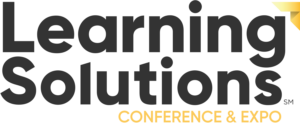The topic of this week’s #lrnchat session was “Disambiguating Terminology”.
Q1) How does confusion about learning terminology affect your work?
Key Learning Points
Language is part of the foundation upon which verbal communication is built. The shared understanding of what a specific word means enables communication to be much more effective. For example, take this statement: “I’m walking to the store”.
‘Walking’ is a pretty universal term. Our strides may be different, but the core definition of what it means to walk is widely accepted. The shared definition of the term saves me from having to provide a more detailed description such as: “I’m moving to the store by advancing my feet alternately so that there is always one foot on the ground in bipedal locomotion”.
Unfortunately, not all language is shared. The deeper you go into any single group or community, the more specific the language becomes. It is still a shared language; the difference is that the size of the group sharing the language is shrinking.
Need more proof? Go check out the WikiPedia page on walking. There’s a huge amount of detail there, and it shows that there’s a lot more going on during the simple act of walking then I ever realized. To me it was a simple act of putting one foot in front of the other; to someone more specialized in walking, it’s much more than that.
Compare this to the language we use to describe what Learning Professionals do. Do our stakeholders define us by the simplest definition of ‘Training’? Do we go into the other extreme and alienate ourselves from our stakeholders by speaking in the jargon of our field?
This week’s #lrnchat focused on the challenges that are created by the language of learning professionals, and those that have a stake in the work that we do.
The discussion started with a simple question: How does confusion in learning terminology affect the work that we do?
I think the direct answer to this question is built into the question itself. When you have confusion around terminology, it is likely going to have some sort of adverse affect on the work that is being done. That adverse affect could be as simple and common as inefficiency and stalled projects, or something much more impactful. Either way, confusion of terminology will likely have some sort of negative impact on the work.
Accepting of that, I find more value in exploring the origins of the confusion itself.
I expect that the origin of the confusion likely stems from the origins of the Learning and Development function itself. In most organizations, the function originated from a top-down, organizational need to onboard individuals. Even as the function evolved, it was still mostly top-down pushing of skills the organization needed employees to apply. All of this fell under the legacy term: “Training”.
The more learner-centric, pull approaches being applied today in most cases did not originate at the organizational level; it originated from the smaller sub-group of the organization’s L&D group. Within that subgroup terms like Learning, Performance, e-Learning. Social Learning, and Community of Practice have shared understanding; outside the sub-group though, it’s all still ‘Training’.
There was discussion during the chat on how we go about educating stakeholders on the terms that we use to discuss learning and performance programs. I don’t agree with that approach. I do believe that the terminology is important; I feel that changing the terminology requires less focus on the terms themselves and more focus on changing the way people look and define what you do. I discussed this idea in a recent post.
Another way Learning Professionals can bridge this communications gap is to be very conscious of the learning terminology we use with stakeholders. We often forget that our ‘terminology’ is often a stakeholder’s ‘Jargon’.
An interesting question was asked during the chat: When does terminology become jargon? I think the concept of jargon is more black-and-white than this question implies, and is linked to the perspective of the individual. If someone is ignorant to what a group-specific term means, then from that individual’s perspective, the terminology is jargon. Jargon isn’t defined by the term or the usage; it’s defined by the knowledge of the person it is expressed to.
From there the discussion moved on to how we manage vendors that use different terminology than is used within our organizations.
I’ve never been concerned about the terminology vendors use in their discussions with me. Even when a vendor is using different terminology, our shared understanding of the work is usually sufficient to bridge the gap so we are on the same page.
Where I do feel it is critical to focus on terminology is when vendors need to speak to stakeholders. It that is going to happen, then it is important that they understand the language that is in use at the organization – including the language that you might be trying to put into use at the organization – and speak to that.
Part of the equation of changing the language of employee learning at an organization is to ensure that the learning professionals (internal and external) are consistently using the chosen language themselves. Marcia Conner echoed the risks of not doing so: “For years I ignored people using ‘Training’ and ‘learning’ interchangeably. Now I see it’s holding organizations back“.
The discussion then shifted to a simple and thought-provoking fill-in-the-blank question regarding terminology: It drives me crazy when people say ________ but they mean ________.
A question like this tends to up the snarky-quotient of responses, and this one did not disappoint. Here are a few of my favorites examples:
@Quinnovator: When people say ‘game’ but mean ‘tarted up quiz show’
@JaneBozarth: When they say training but mean presentation
@Mary_a_Myers: It drives me crazy when people say INTERACTIVE but they mean READ & CLICK NEXT
@britz: It drives me crazy when people say JUST IN TIME but they mean JUST IN CASE
@marciamarcia: It drives me crazy when people say YES but they mean NO
@JaneBozarth: When they say evaluation but mean assessment. And vice versa
@marciamarcia: It drives me crazy when people say “learning” when they mean “training.” Both are important & mean diff things!
@NYChase: When people say “eLearning” but really (just) mean PowerPoint uploaded to the LMS
@odguru: When they say ROI but they mean CYA
The discussion then shifted towards examples of when confusion over a learning term led to problems because people weren’t speaking the same language. Most participants seemed to agree that this is a fairly common occurrence.
I once had a conversation with a stakeholder on a program he was looking for me to develop. There was something in place before I joined the organization, which I would define as a presentation. As we were discussing how we might do things differently, specifically talking about ways to get the learners involved, the stakeholder was focusing on my use of the word ‘engaging’. His perspective – which is not unique outside of the L&D community – was that people were required to participate in the training and did not need to be engaged. We were looking at this concept of engagement from two different perspectives.
Ultimately, my perspective didn’t matter. After all, it was his program, not mine. Still, I had the responsibility to ensure it would be a success, and we needed to get on the same page during this discussion. Ultimately, it was a slight slip on my part that got us there.
“You’re right – they are required to participate. Wouldn’t it be better if they gave a $h!t while they did?”
Thankfully I have a good enough relationship with the stakeholder that not only did my comment warrant a chuckle, it also bridged our language gap.
The discussion concluded with an exploration of what we might do to implement learning terminology standards across the industry.
Personally, I wouldn’t bother to try to standardize the language outside of the community of professionals. The language of the industry is almost irrelevant if the stakeholders don’t speak it. As Clark Quinn stated during the chat “actually, our terminology hurts us because we’re not speaking ‘business’“.
I think standard terminology is important, but it’s a distant second to clarity of your message. Learning terminology is something I use with my peers in the learning community, and something I avoid to help conversations with everyone else.
Ultimately I think focusing on the confusion caused by learning terminology targeting the symptom, not the disease. It’s true that confusing terminology is a problem – one that is itself a subset of a larger one. The root cause of the terminology confusion is not having effective conversations in the first place.
It’s for that reason that I try not to use the terms at all outside of the learning community. When I speak with stakeholders, I just talk about what it is we need people to DO.







